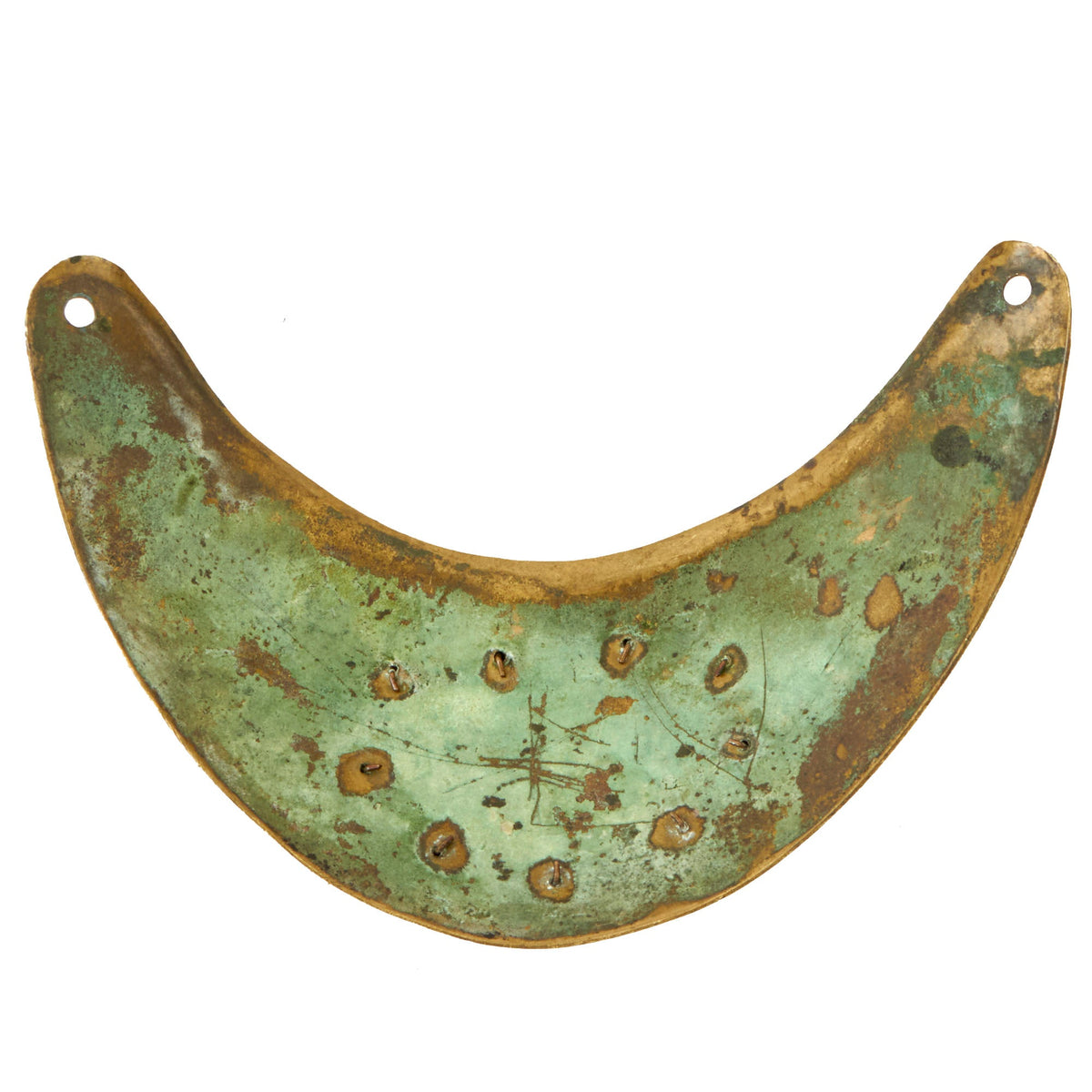Original 19th Century French July Monarchy National Guard Officers “Liberté” Brass Gorget with Gallic Rooster Original Items
$ 395,00 $ 118,50
Original Item: Only One Available. This is a lovely example of a 19th Century French “July Monarchy” Era Officer’s Gorget, as worn by the French “National Guard”. A gorget , from the French gorge meaning throat, was a band of linen wrapped around a woman’s neck and head in the medieval period or the lower part of a simple chaperon hood. The term later described a steel or leather collar to protect the throat, a set of pieces of plate armor, or a single piece of plate armor hanging from the neck and covering the throat and chest. Later, particularly from the 18th century, the gorget became primarily ornamental, serving as a symbolic accessory on military uniforms, a use which has survived in some armies.
The gorget is constructed out of brass which has tarnished to a lovely patina, and the insignia features the Gallic Rooster with the right wing raised and looking to the left, with the left good on a globe bearing the French motto LIBERTÉ. The other foot is grasping the oak leaf wreath that surrounds the entire insignia. In the Middle Ages, the Gallic Rooster was widely used as a religious symbol, the sign of hope and faith. It was during the Renaissance that the rooster began to be associated with the emerging French nation. With time, the French kings adopted the rooster as a symbol of courage and bravery.
There were numerous different gorget designs used by the French during the 19th century, which was also a time of numerous revolutions and different governments. We have found referent materials linking this specific design to the “July Monarchy” period that preceded the 2nd Empire, though it is very possible that the design continued to be used into that period.
The condition of the gorget is in very good condition for its age, displaying a lovely mellow brass patina. There is some deformation to the brass, and there is also some minor oxidation and patination present on the reverse. The insignia is well preserved, with a lovely antiqued look.
A lovely example ready for further research and display.
The July Monarchy (Monarchie de Juillet), officially the Kingdom of France (Royaume de France), was a liberal constitutional monarchy in France under Louis Philippe I, starting on 26 July 1830, with the July Revolution of 1830, and ending 23 February 1848, with the Revolution of 1848. It marks the end of the Bourbon Restoration (1814–1830). It began with the overthrow of the conservative government of Charles X, the last king of the main line House of Bourbon.
Louis Philippe, a member of the more liberal Orléans branch of the House of Bourbon, proclaimed himself as Roi des Français (“King of the French”) rather than “King of France”, emphasizing the popular origins of his reign. The king promised to follow the juste milieu, or the middle-of-the-road, avoiding the extremes of both the conservative supporters of Charles X and radicals on the left.
The July Monarchy was dominated by wealthy bourgeoisie and numerous former Napoleonic officials. It followed conservative policies, especially under the influence (1840–48) of François Guizot. The king promoted friendship with the United Kingdom and sponsored colonial expansion, notably the French conquest of Algeria. By 1848, a year in which many European states had a revolution, the king’s popularity had collapsed, and he abdicated.
Fast Shipping with Professional Packaging
Thanks to our longstanding association with UPS FedEx DHL, and other major international carriers, we are able to provide a range of shipping options. Our warehouse staff is expertly trained and will wrap your products according to our exact and precise specifications. Prior to shipping, your goods will be thoroughly examined and securely secured. We ship to thousands clients each day across multiple countries. This shows how we're dedicated to be the largest retailer on the internet. Warehouses and distribution centres can be located throughout Europe as well as the USA.
Note: Orders with more than one item will be assigned a processing date depending on the item.
Before shipping before shipping, we'll conduct a thorough inspection of the items you have ordered. Today, the majority of orders will be delivered within 48 hours. The delivery time will be between 3-7 days.
Returns
The stock is dynamic and we cannot completely manage it because multiple stakeholders are involved, including our factory and warehouse. So the actual stock may alter at any time. It's possible that you may not receive your order once the order has been made.
Our policy is valid for a period of 30 days. If you don't receive the product within 30 days, we are not able to issue a refund or an exchange.
You can only return an item if it is unused and in the same state as the day you received it. You must have the item in its original packaging.
Related products
Uncategorized
Uncategorized
Uncategorized
Uncategorized
Angolan Rebel 1970s era 60mm Inert Display Mortar from Angolan Civil War Original Items
Uncategorized
Uncategorized
Band of Brothers ORIGINAL GERMAN WWII Le. F.H. 18 10.5cm ARTILLERY PIECE Original Items
Uncategorized
Armoured Fighting Vehicles of the World: AFVs of World War One (Hardcover Book) New Made Items
Uncategorized
Australian WWII Owen MK1 Machine Carbine SMG Custom Fabricated Replica with Sling Original Items
Uncategorized
Uncategorized
Uncategorized
Uncategorized
Armored Burgonet Helmet & Polearm from Scottish Castle Leith Hall Circa 1700 Original Items
Uncategorized
Uncategorized
Uncategorized
Uncategorized
Uncategorized
Uncategorized










































































